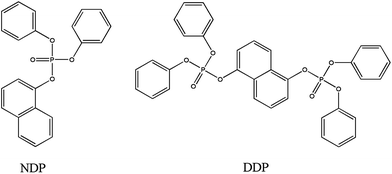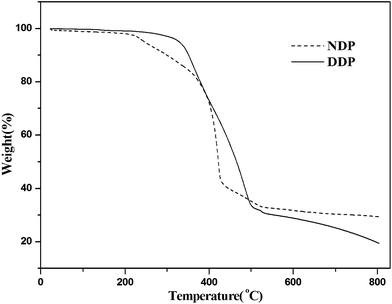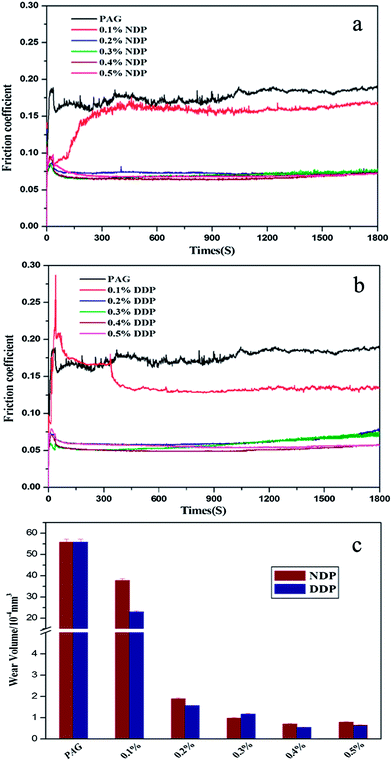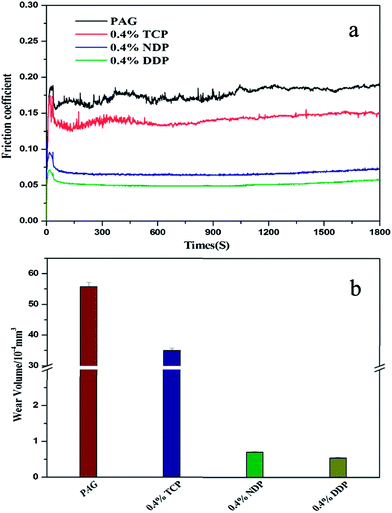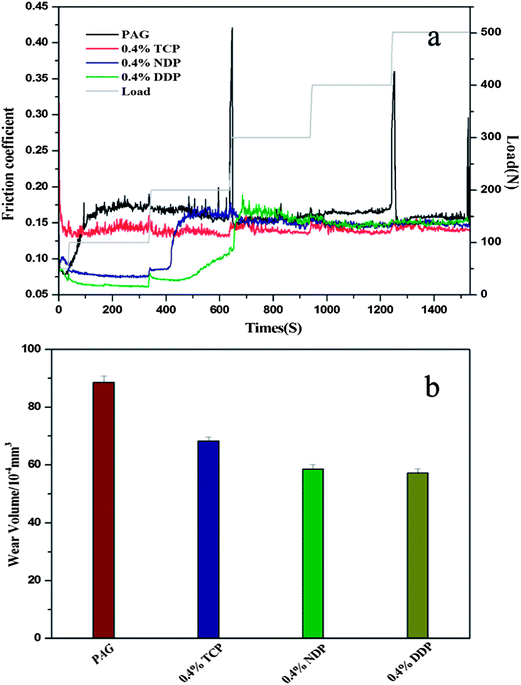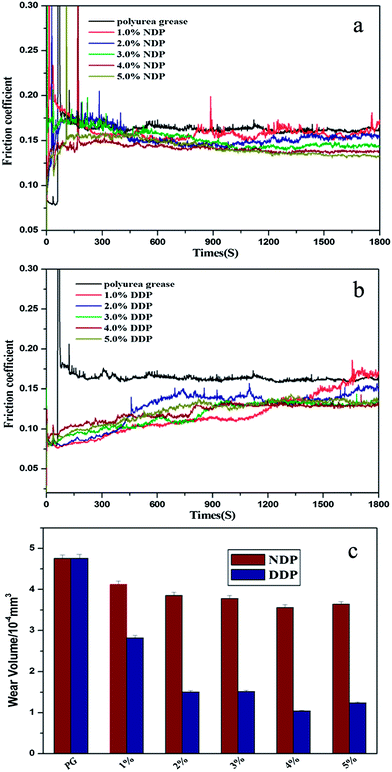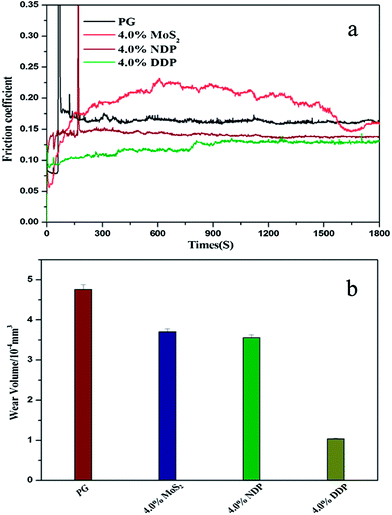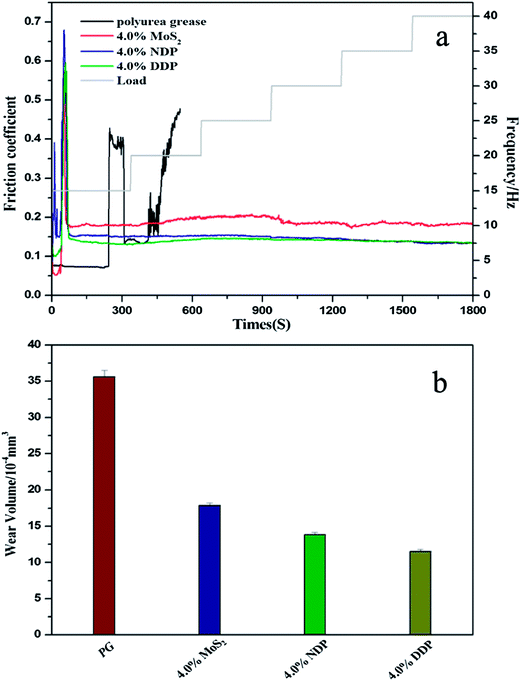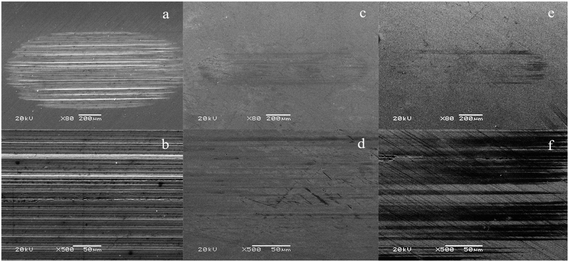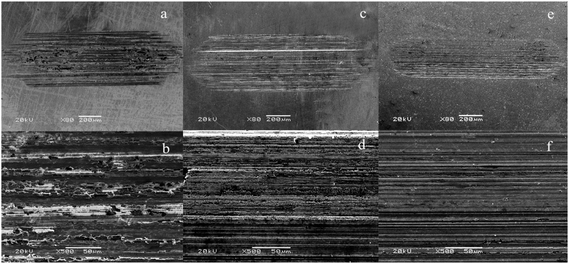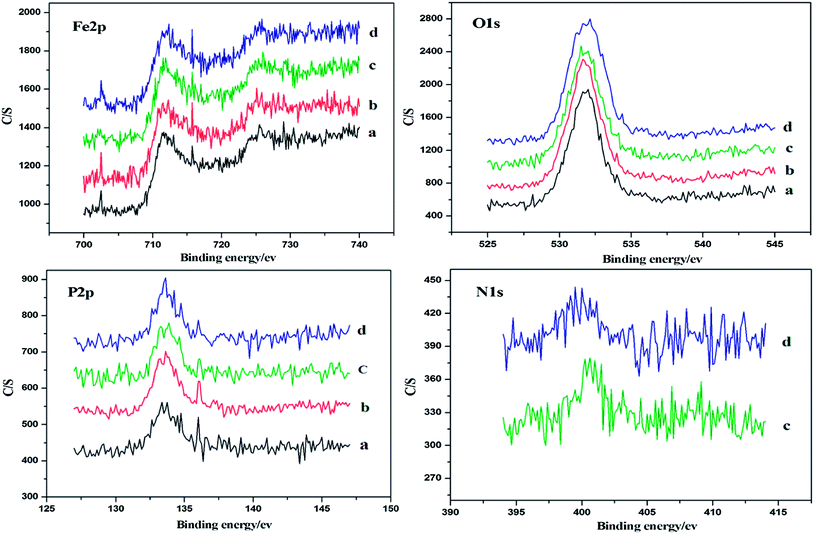Tribological properties of naphthyl phenyl diphosphates as antiwear additive in polyalkylene glycol and polyurea grease for steel/steel contacts at elevated temperature
Xinhu Wu,
Xiaobo Wang* and
Weimin Liu
State Key Laboratory of Solid Lubrication, Lanzhou Institute of Chemical Physics, Chinese Academy of Sciences, Lanzhou 730000, People's Republic of China. E-mail: wangxb@lzb.ac.cn
First published on 19th December 2013
Abstract
Naphthyl phenyl diphosphates: 1-naphthyl diphenyl phosphate (NDP) and 1,5-dihydroxynaphthalene bis(diphenyl phosphate) (DDP) were evaluated as the antiwear additives in polyalkylene glycol and polyurea grease at 200 °C. Results showed that they could effectively reduce the friction and wear of sliding pairs compared with the cases without these additives. Furthermore, the tribological properties of NDP and DDP were generally better than the normally used tricresyl phosphate (TCP) in PAG and molybdenum disulfide (MoS2) in polyurea grease. Boundary lubrication films composed of Fe(OH)O, Fe3O4, FePO4 were formed on the worn surface, which resulted in excellent friction reduction and antiwear performance.
1. Introduction
With rapid advances in aircraft, turbines, automobiles, trucks, farm equipment, railroad equipment, industrial machinery, etc., there is an increasing demand for lubricants that can successfully operate under conditions of high loads, high speeds and high temperatures.1–6 For instance, the working temperature of aviation gas turbine engine oils often exceeds 200 °C. Under such high temperature, conventional lubricating oils are subjected to such hot operating conditions, decomposition of the petroleum ingredient eventually occurs, with the formation of end products which are hard, abrasive, carbonaceous or coke-like materials which reduce clearance between rubbing members and tend to promote wear. To address these problems, various high-performance base fluids or base greases such as polyalpha olefins (PAO), polyalkylene glycol (PAG), lithium complex soap greases and polyurea greases, etc. were developed to meet the demand for high temperature lubricants.7–11 However, only a few high temperature lubricant additives especially anti-wear (AW) additives were commercially available, which limits the formulation of high temperature lubricants. Thus it is essential to do some research on lubricating additives under high temperature.Many different types of phosphate esters have been examined as additives for lubricating oils or greases, with most attention given to their potential as antiwear (AW) additives at elevated temperature. For example, tricresyl phosphate (TCP) has been used as an antiwear additive in jet oils for many years.1 Hydroquinone bis(diphenyl phosphate) (HDP) exhibited excellent friction-reducing and anti-wear performance in polyalkylene glycol (PAG) at 200 °C.12 The excellent tribology performances of phosphate esters can be explained that phosphorus containing additives can be film-forming on the metal surfaces at ∼200 °C,13 and provide an extremely low friction coefficient between 250 and 550 °C.14 The film can cause a smoothing of the metal surface that is then able to proving a low shear strength boundary layer. Consequently, phosphate esters, especially that have advantages of high molecular weight and high thermal and chemical stability as well as very low vapor pressure, could be potential candidates as high temperature lubricating additives.
1-Naphthyl diphenyl phosphate (NDP) and 1,5-dihydroxynaphthalene bis(diphenyl phosphate) (DDP) are halogen free, phosphorus based flame retardants and have advantages of high molecular weight and low volatility, indicating that they might be promising candidates as AW additives under high temperature in lubricating additives.15 However, the existing studies of NDP and DDP are on the effects of flame retardant,15 there have no studies on the tribological properties of NDP and DDP, specifically as AW additives under harsh friction conditions. In the present paper, the tribological properties of NDP and DDP in polyalkylene glycol and polyurea grease for steel/steel contacts were evaluated on an Optimal SRV-IV oscillating friction and wear tester at 200 °C. The morphology and chemical composition of worn surface were studied by SEM and XPS in order to explore the lubrication mechanism of NDP and DDP under high temperature.
2. Experimental section
2.1. Chemicals
The chemical structures of NDP and DDP are given in Fig. 1, which were synthesized using previously reported method.16 Diphenyl chlorophosphate (≥99.0%), 1-naphthol (≥99.0%) and 1,5-dihydroxynaphthalene (≥98.0%) were obtained from J & K Chemical. Tricresyl phosphate (TCP, ≥99.0%) were purchased from Tianjin Chemical Reagent no. 1 Plant. Molybdenum disulfide (MoS2, particle size of 0.5 micron) was also commercially obtained from Shanghai Shen Yu Industry & Trade Co., Ltd. All the chemicals were of the AR grade and utilized in this work without further purification.Synthesis of 1-naphthyl diphenyl phosphate (NDP) and 1,5-dihydroxynaphthalene bis(diphenyl phosphate) (DDP): 1.44 g (10.0 mmol) 1-naphthol, 2.68 g (10.0 mmol) diphenyl chlorophosphate, 0.2 g AlCl3 and 50 mL toluene were introduced into a dry 100 mL four-necked flask with a thermocouple, a dip tube for N2 purge, a product condenser and a vacuum receiver. The mixture was heated to 100 °C while keeping the flask devoid of moisture. After being stirred at this temperature for 20 hour, toluene was removed and the resultant precipitate was washed repeatedly with water and acetonitrile. A white powder 3.2 g (yield of 85.0%) was obtained after drying under vacuum at 80 °C, until a constant weight. DDP was synthesized using same method and a grey white powder product was obtained (yield of 89.0%). The structures of the prepared compounds were characterized by infrared spectroscopy (FTIR), proton nuclear magnetic resonance (1H-NMR, 400 MHz) and carbon nuclear magnetic resonance (13C-NMR, 100 MHz) spectroscopy.
NDP: FTIR (KBr disc): 3070, 1590, 1490, 1231, 1205, 1130, 1022, 960, 773, 684, 565, 501 cm−1. 1H-NMR (DMSO-d6, 400 MHz), (δ/ppm): 6.97 to 8.20. 13C-NMR (DMSO-d6, 100 MHz), (δ/ppm): 152.57, 152.51, 150.64, 150.34, 134.77, 129.84, 127.71, 126.43, 125.84, 125.60, 125.56, 125.33, 124.41, 121.44, 120.82, 120.45, 119.99, 115.41, 115.75.
DDP: FTIR (KBr disc): 3060, 1590, 1490, 1401, 1310, 1238, 1211, 1192, 1061, 990, 966, 938, 782, 756, 684, 567, 507, 481, 410 cm−1. 1H-NMR (DMSO-d6, 400 MHz), (δ/ppm): 6.75 to 7.83, 4.18, 1.30, 0.86. 13C-NMR (DMSO-d6, 100 MHz), (δ/ppm): 152.50, 150.36, 150.29, 146.16, 146.09, 130.79, 129.80, 129.27, 128.67, 127.47, 126.69, 124.04, 122.32, 120.49, 120.44, 119.23, 117.0.
The selected lubricating base fluid PAG was obtained from HENUVAR Chemical Corporation and its typical properties was listed in previous work.12 Polyurea grease was obtained from our laboratory. Its typical properties are listed in Table 1. The base grease and additives with different concentrations were mixed thoroughly prior to the tests. Briefly, the grease was combined with 3 wt% of additives. For full dissolution, 97 wt% of the polyurea grease was then added to the additivated grease by agitation with a mechanical stirrer and finely ground three times in a three-roller mill.
| Item | Result | Test method |
|---|---|---|
| Polyurea grease | ||
| Work penetration (1/10 mm) | 320 | GB/T 269 |
| Dropping point (°) | 290 | GB/T 498 |
| Copper corrosion (T2 copper, 100 °C, 24 h) | 1b | GB/T 7326 |
| Steel mesh sub-oil (100 °C, 24 h) (%) | 3.64 | SH-T 0324 |
| Evaporative capacity (99 °C, 22 h) (%) | 0.30 | GB/T 7326 |
| Similar viscosity (−10 °C, 10 s−1) (Pa S) | 450 | SH/T0048 |
| Shuilin loss of volume (38 °C, 1 h) (%) | 1.5 | SH/T0109 |
2.2. Thermal analysis
The thermal behaviours of the sample were studied on a STA 449C Jupiter®-simultaneous thermo-gravimetry and differential scanning calorimetry (TG-DSC). A total of 5 mg of sample was placed in the TGA sample holder. The temperature was programmed to increase from ambient temperatures to approximately 800 °C, at a heating rate of 10 °C min−1 in air. The weight loss was monitored in the TG-DSC analysis.2.3. Tribology test
The Optimol SRV-IV oscillating reciprocating friction and wear test was performed with a ball-on-disk configuration. The upper ball (diameter 10 mm, AISI 52100 steel, hardness of approximately 58–60 HRC) slides reciprocally against the lower stationary disk (ø 24 mm × 7.9 mm, AISI 52100 steel). All the SRV tests were conducted at 200 °C, 25 Hz oscillation frequency, 1 mm amplitude, for 30 min test duration, and the relative humidity is 20–40 wt%. The corresponding friction curves were recorded automatically with a charter attached to the SRV test rig. The volume losses from lower discs were measured using a MicroXAM-3D non-contact surface mapping microscope profilometer. Three repetitive measurements were performed for each wear of the discs, and the averaged values are reported in this paper.The morphologies of the worn surfaces were analyzed by a JSM-5600LV scanning electron microscope (SEM). The X-ray photoelectron spectrometry (XPS) analysis was carried out on a PHI-5702 multifunctional X-ray photoelectron spectrometer, using Al Kα radiation as the exciting source. The binding energies of the target elements were determined at a pass energy of 29.35 eV, with a resolution of about ±0.3 eV, using the binding energy of contaminated carbon (C 1s, 284.8 eV) as ref. 17.
3. Result and discussion
3.1. Thermal stability
The TGA curves of NDP and DDP are presented in Fig. 2. It is seen that the two additives does not exhibit any weight loss below 200 °C and the decomposition temperatures for NDP and DDP are 422.4 and 465.8 °C, respectively. Furthermore, the temperature for total decomposition is over 800 °C, indicating the high thermal stability. DDP exhibited better thermal stability than NDP.3.2. Tribological properties of NDP and DDP as additives in PAG
The tribological properties of NDP and DDP in PAG at 200 °C were first investigated. The coefficient of friction evolution and wear volume of sliding discs are shown in Fig. 3. It is seen that pure PAG has a relatively large friction coefficient, while the addition of 0.2 wt% NDP and DDP can dramatically reduce the friction coefficient (Fig. 3a and b). When the concentration increases to 0.4 wt%, the friction coefficient decreases to a comparatively low level. No significant improvement can be observed after 0.5 wt% concentration. Meanwhile, the AW properties of 0.4 wt% NDP and 0.4 wt% DDP increased by 79 and 102 times as compared with the base oil (Fig. 3c), respectively. It shows the best friction reduction and AW capability when the additives concentration of NDP and DDP reach 0.4 wt% under the testing conditions. Moreover, as shown in Fig. 4, 0.4 wt% NDP and DDP in PAG can significantly improve the friction reduction and antiwear properties of PAG compared to base oil containing 0.4 wt% TCP, a very popular phosphorus containing additive, this result indicates that both of NDP and DDP are excellent additives of PAG, exhibiting outstanding friction reduction and AW properties, especially during the constant load test at elevated temperature.Fig. 5 shows a load ramp test stepped from 100 N up to 500 N by 100 N intervals at a frequency of 25 Hz for PAG + 0.4 wt% TCP, PAG + 0.4 wt% NDP and PAG + 0.4 wt% DDP at 200 °C. The test duration for each load is 5 min. We can see that the base oil exhibits relatively high friction coefficient and the friction coefficient fluctuated a few times. For 0.4 wt% NDP and 0.4 wt% DDP, in the initial friction stage, the two additives may form boundary lubricating films and the curve shapes were stable for the initial 400 s and 600 s, respectively (Fig. 5a). Then the boundary films might be worn away and could not complement rapidly probably because of high loads, the friction coefficient suddenly increased to 0.160, and afterward stabilized at the value equal to that of pure PAG. However, TCP as comparison exhibits relatively high friction coefficient all the time under the same conditions. Fig. 5b displays the wear volumes of the lubricants increased in the following sequence: DDP < NDP < TCP < PAG. The ability of NDP and DDP to stabilize friction is not that prominent, but the enhancement of the AW property is. This result further proves the friction-reducing and antiwear proprieties of NDP and DDP.
3.3. PDP and TDP as additives for polyurea grease (PG)
In modern-day engineering, polyurea greases are increasingly and widely used. This is because they have many excellent properties, such as high oxidation stability, high-temperature performance, and high mechanical stability.18 Fig. 6 displays the effect of the concentration on the tribological behavior of 1–5 wt% NDP and DDP in polyurea grease. This is under the same test conditions (at a constant load of 100 N, a temperature of 200 °C and the frequency was 25 Hz) as that in Fig. 3. Fig. 7 shows the variation in the friction coefficients and wear volumes of the sliding discs under lubrication of polyurea grease plus 4 wt% NDP and 4 wt% DDP at a constant load of 100 N and 200 °C. and their tribological behavior were compared with MoS2, which is one of the traditional AW additives for lubricating greases.19,20 The results showed that the friction coefficients of the additives and polyurea grease increased in the following sequence: DDP < NDP < polyurea grease < MoS2, and the wear volumes of the discs increased in the following sequence: DDP < NDP < MoS2 < polyurea grease. The results indicate that NDP and DDP as the additives in polyurea grease have better friction reduction and AW properties than MoS2, and the poor friction reduction performance of MoS2 might be relevant to the oxidation of itself at high temperature and the products of MoS2 oxidation can cause an increase of friction.21 Furthermore, it is clearly seen that the effect of additive concentration on tribological properties of PAG and polyurea grease is very different. In PAG, the friction is more sensitive to the additives at low concentration and significant friction reduction and antiwear performance occur. This is in contrast to that in polyurea grease, where the optimum concentration is 4 wt%. The possible reason might be relevant to the freedom of additives in PAG and polyurea grease. In PAG, the freedom of additive molecules is fairly large and they can form boundary film at interface more rapidly once boundary film is swept away, whereas in polyurea grease, the additive molecules at interface cannot be supplied timely due to the non-flowing character and restricted motion of additive molecules.Fig. 8 shows frequency ramp test amplified from 15 Hz up to 40 Hz in 5 Hz, intervals. The test was conducted under a load of 200 N for the three kinds of additives in polyurea grease at 200 °C. The test duration for each frequency was 5 min. It is seen that 4 wt% MoS2, 4 wt% NDP and 4 wt% DDP also experienced a running-in time with larger friction coefficients, afterward they could reduce friction and rendered a stable and smaller friction coefficient (Fig. 8a). Polyurea grease exhibits much high friction coefficient (>0.5) under the same conditions, and so the test had to be stopped after 9 min. Fig. 8b demonstrates that wear volumes increased in the following sequence: 4 wt% DDP < 4 wt% NDP < 4 wt% MoS2 < polyurea grease. This is consistent with the result shown in Fig. 7. Both the friction reduction and AW wear capability of DDP was prominent during the test. These results verify DDP as additive in the polyurea grease both in the constant load and variable frequency tests have better tribological performance for steel/steel contacts at 200 °C. This may be attributed to high thermal stability, and the capability to form effective boundary films.22,23 However, the ability of NDP to reduce friction and wear in polyurea grease is not that prominent, the possible reason might be relevant to the differences of thermal stability, phosphorus content and molecular polarity between NDP and DDP.
3.4. Surface analysis
Fig. 9 and 10 display the SEM micrographs of the worn surfaces of steel discs lubricated by different lubricants at 100 N and 200 °C. It is clearly seen that the worn surfaces of steel discs lubricated by pure PAG and PG exhibit considerably wider and deeper wear scars, with a number of deep and narrow grooves (PAG: Fig. 9a and b; PG: Fig. 10a and b). Thus, severe scuffing occurs in these cases. The addition of 4.0 wt% NDP in PG can make the worn surface of the steel becomes relatively narrow and shallow, showing that NDP has some certain AW property (Fig. 10c and d). When 4.0 wt% DDP is added into PG, not only does the width of wear scars become smaller in size, but the abrasions are also fewer and smoother (Fig. 10e and f). This is consistent with previously measured wear volume. In marked contrast, the wear scars of the steel discs lubricated by 0.4 wt% NDP and DDP in PAG are much narrower and shallower, and scuffing is greatly alleviated, indicating a significantly improved antiwear behavior by simple addition of NDP and DDP (PAG + NDP: Fig. 9c and d; PAG + DDP: Fig. 9e and f). These results are consistent with previously measured wear volume results and indicate undoubtedly the excellent anti-wear properties of NDP and DDP as additives for PAG.To gain further insight into the lubricating mechanism of NDP and DDP, Fig. 11 presents the XPS spectra and Table 2 gives the atomic percent on the worn steel surfaces lubricated by 0.4 wt% NDP + PAG, 0.4 wt% DDP + PAG, 4 wt% NDP + PG and 4 wt% DDP + PG, respectively. It can be seen that all peaks of Fe2p (Fig. 11a–d) appear at approximately 711.6 and 725.5 eV, which may correspond to Fe(OH)O and Fe3O4.24,25 Almost no difference is observed in XPS peaks of O1s (Fig. 11a–d) on the worn surfaces. The peak of O1s appears at 531.5 eV, which may correspond to Fe(OH)O.26,27 Fig. 11c and d display the N1s spectra of the worn surface lubricated by polyurea grease plus 4 wt% NDP and 4 wt% DDP at 401.0 eV, possibly corresponding to nitrogen oxide or nitrogen double bond compounds.24,27 XPS peak of P2p (Fig. 8a–d) appearing at 133.7 eV may correspond to FePO4.12,24,28
| Additive | Binding energy (eV) | O | P | N | |
|---|---|---|---|---|---|
| Fe | |||||
| a | PAG + 0.4 wt% NDP | 712.1, 725.5 | 531.5 | 133.5 | |
| b | PAG + 0.4 wt% DDP | 711.7, 725.5 | 531.7 | 133.6 | |
| c | PG + 4 wt% NDP | 711.7, 725.5 | 531.7 | 133.6 | 401.1 |
| d | PG + 4 wt% DDP | 711.6, 725.5 | 531.5 | 133.5 | 401.0 |
From the above explanations, it is suggested that chemical reactions occurred on the wear surface in the frictional process with the generation of a surface-protective film composed of Fe(OH)O, Fe3O4, FePO4 and compounds containing nitrogen oxide, etc., which significantly contribute to the friction-reducing and antiwear properties of NDP and DDP in PAG and polyurea grease at elevated temperature.
4. Conclusions
Two naphthyl phenyl diphosphates: 1-naphthyl diphenyl phosphate (NDP) and 1,5-dihydroxynaphthalene bis(diphenyl phosphate) (DDP) were synthesized and their tribological properties have been studied as high temperature friction-reducing and anti-wear additives in PAG and polyurea grease at 200 °C. The friction and wear test results show that the two additives have excellent friction reducing and antiwear properties for the lubrication of steel/steel contacts. This may be attributed to high thermal stability, and the capability to form effective boundary films. Furthermore, the tribological properties of NDP and DDP were generally better than the normally used tricresyl phosphate (TCP) in PAG and MoS2 in polyurea grease. XPS analysis indicated that the good tribological performance of NDP and DDP are attributed to the formation of a boundary lubrication film composed of Fe(OH)O, Fe3O4 and FePO4. The film was generated on the worn surface, leading to good friction reduction and AW performance at high temperature.Acknowledgements
The authors are thankful for financial support of this work by “973” Program (2013CB632301).References
- R. M. Mortier, M. F. Fox and S. T. Orszulik, Chemistry and Technology of Lubricants, Springer, New York, 2010 Search PubMed.
- H. K. Trivedi, N. H. Forster and C. S. Saba, Tribol. Lett., 2004, 16, 231 CrossRef CAS.
- M. J. Neale, The Tribology Handbook, Butterworth-Heinemann, Oxford, 1995 Search PubMed.
- B. K. Sharma, A. Adhvaryu, J. Perez and S. Z. Erhan, J. Agric. Food Chem., 2006, 54, 7594 CAS.
- C. J. Boner, Manufacture and Applications of Lubricating Greases, Krieger, R. E. Publishing Co, Huntingdon, NY, 1971 Search PubMed.
- C. J. Boner, Modern lubricating greases, Scientific Publications, England, 1976 Search PubMed.
- L. R. Rudnick and R. L. Shubkin, Synthetic Lubricants And High-Performance Functional Fluids, Revised And Expanded, Taylor & Francis, New York, 1999 Search PubMed.
- B. Cavdar, Wear, 1997, 206, 15 CrossRef CAS.
- M. Masuko, S. Hirose and H. Okabe, Lubr. Eng., 1996, 52, 641 CAS.
- J. Kang and Y. Z. Zhao, Synth. Lubr., 2005, 2, 25 Search PubMed.
- T. Q. Guo, M. J. Jiang, X. C. Guo, C. S. Li, K. S. Cheng and S. H. Liu, Lubr. Eng., 2006, 1, 164 Search PubMed.
- G. Q. Zhao, X. H. Wu, W. M. Li and X. B. Wang, Ind. Eng. Chem. Res., 2013, 52, 7419 CrossRef CAS.
- R. Mandakovic, J. Synth. Lubr., 1999, 16, 13 CrossRef CAS.
- L. R. Rudnick, Lubricant Additives Chemistry and Applications, 2nd edn, RSC, New York, 2009 Search PubMed.
- K. Tamura and C. Wang, U.S. Patent 2004254390A1, 16 December 2004.
- J. Zilberman, D. Canfi and A. Gregor, U.S. Patent 20120022193 A1, 26 January 2012.
- J. F. Moulder, W. F. Stickle, P. E. Sobol and K. D. Bomben, Handbook of X-ray Photoelectron Spectroscopy, Perkin Elmer, Eden Prairie, MN, 1992 Search PubMed.
- F. L. Yu, R. L. Zhang, C. X. Xie and S. T. Yu, Tetrahedron, 2010, 66, 9145 CrossRef CAS PubMed.
- C. Roland, J. Twigg, Y. Vu and P. Mott, Polymer, 2007, 48, 574 CrossRef CAS PubMed.
- J. P. Sheth, E. Yilgor, B. Erenturk, H. Ozhalici, I. Yilgor, L. Garth and G. L. Wilkes, Polymer, 2005, 46, 8185 CrossRef CAS PubMed.
- Y. Epshteyn and T. J. Risdon, Presented at the 12 Lubricating Grease Conference, NLGI-India Chapter, January 2010, pp. 28–30 Search PubMed.
- A. Hernández Battez, R. González, J. L. Viesca, D. Blanco, E. Asedegbega and A. Osorio, Wear, 2009, 266, 1224 CrossRef PubMed.
- H. Kamimura, T. Kubo, I. Minami and S. Mori, Tribol. Int., 2007, 40, 620 CrossRef CAS PubMed.
- M. R. Cai, Y. M. Liang, F. Zhou and W. M. Liu, ACS Appl. Mater. Interfaces, 2011, 3, 4580 CAS.
- National Institute of Standards and Technology, NIST X-ray Photoelectron Spectroscopy Database, version 4.1, 2012, http://srdata.nist.gov/xps/ Search PubMed.
- Y. B. Sun, L. T. Hu and Q. J. Xue, Wear, 2009, 266, 917 CrossRef CAS PubMed.
- M. R. Cai, Y. M. Liang, M. H. Yao, Y. Q. Xia, F. Zhou and W. M. Liu, ACS Appl. Mater. Interfaces, 2010, 2, 870 CAS.
- M. H. Yao, Y. M. Liang, Y. Q. Xia and F. Zhou, ACS Appl. Mater. Interfaces, 2009, 1, 467 CAS.
| This journal is © The Royal Society of Chemistry 2014 |

